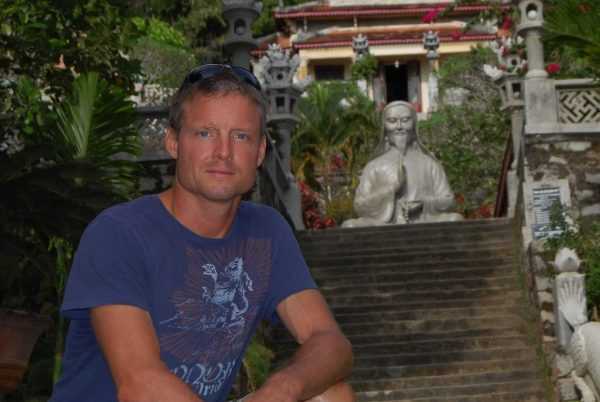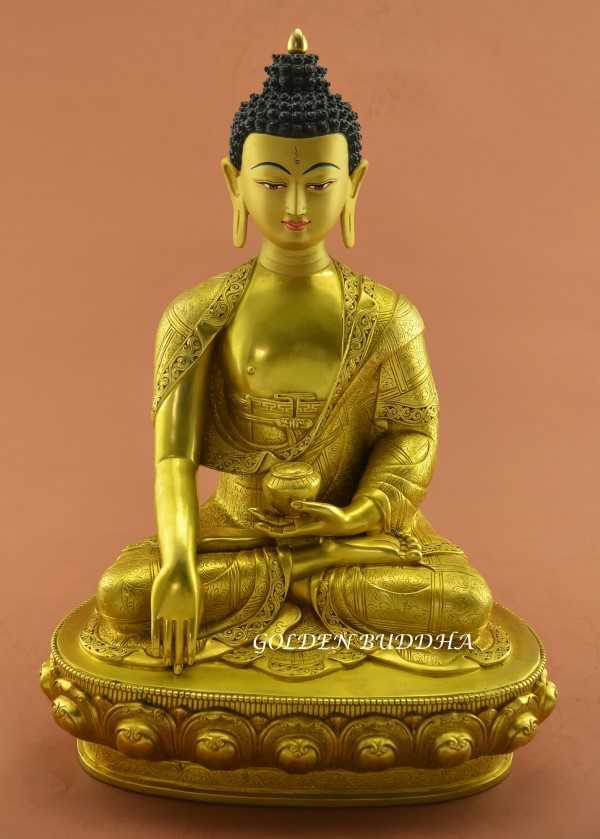What is the true meaning behind Shakyamuni statues? A Shakyamuni statue portrays the real Buddha of our time. The “Buddha of our Time” rediscovered the Dharma after it had been long forgotten by sentient life and reintroduced it in our kalpa.
It should also be noted that Shakyamuni Buddha was his own teacher and discovered the Dharma completely on his own. Essentially for sentient beings, he also revealed the Dharma by teaching his contemporaries how to find the path to enlightenment.
Unfortunately, in Western civilization this concise definition leaves many questions unanswered. The Buddha was formerly a Prince named Siddhartha that walked the earth 2500 years ago. He felt unfulfilled and sought to fill in the emptiness with self enlightenment.
His quest for enlightenment was revealed by the prophecy of Dipankara Buddha millions of years ago, in addition to the final mortal life of Shakyamuni Buddha and his parinirvana.
Introduction to Shakyamuni Statues
- The Meaning of “Shakyamuni” Buddha
- Why is Shakyamuni Buddha so Important?
- What is a Sammasambuddha?
- Before and After Shakyamuni Buddha
- Where was Shakyamuni Buddha Born?
- The Compassion of Shakyamuni Buddha
- What is the Origin of Buddhism?
- Who was Prince Siddhartha Gautama?
- The Prophecy of Shakyamuni Buddha
- The Birthday of the Buddha
- Buy the Best Shakyamuni Statues Direct from Nepal
The Meaning of “Shakyamuni” Buddha
Shakya-muni is two words in one. 1) Shakya was a civilization that existed in Northern India at the time of the Buddha. Additionally, “Shakya” means “the one who is capable”. 2) Muni is Pali for “to know” and also “monk”. Therefore, the basic Shakyamuni Buddha meaning is “omniscient one”.
Furthermore, “Buddha” is the Pali term for “the Enlightened one”. As a result, the words “Shakyamuni” and “Buddha” could be considered synonyms. However, Shakyamuni Buddha was also a “Sammasambuddha”. A Sammasambuddha only appears after Buddhism has disappeared from a world system. Read more below about this important phenomenon.

Shakyamuni Statues Portray the “Buddha of our Time”
Although Buddhism has existed for many thousands of eons, it tends to ebb and flow. Indeed, during different time periods Buddhism has been forgotten and disappeared, so it needed to be reintroduced to sentient life. This is what happened in our world system, Buddhism had ceased to exist and it was rediscovered.
Shakyamuni Buddha would rediscover Buddhism – so to speak. Additionally, he rediscovered it completely on his own, without a teacher or any references. Therefore, Shakyamuni Buddha is the Buddha of our era who rediscovered the Dharma on his own accord and reintroduced it to sentient life.
His willingness to teach the Dharma is also very important because not all Buddhas choose to teach the Dharma after they discover it e.g. silent Buddha or Paccekabuddha. In fact, according to a passage found in the Ayacana Sutta, even Shakyamuni Buddha had second thoughts about teaching the Dharma.
Indeed, he was very skeptical that it would be possible for most humans to follow the path. Fortunately, he was convinced otherwise by someone named – Brahma Sahampati.
What is a Sammasambuddha?
Shakyamuni statues portray what is known as a Sammasambuddha. In Pali, Sammasambuddha means “perfectly enlightened one”. This is because Shakyamuni Buddha not only rediscovered the Dharma without any assistance, but he also reintroduced it in an era when it had disappeared.
There can be only one “original” Buddha for each era and Shakyamuni is the Buddha of our time. Although there are other forms of enlightened beings and even other Buddhas in our era, there is only one Sammasambuddha.
Before and After Shakyamuni Buddha
The predecessor of Shakyamuni was Dipankara Buddha who was the Buddha of the previous world system. Furthermore, it is prophesied that the successor of Shakyamuni Buddha will be Maitreya Buddha. He will come at a time when sentient life has forgotten the Dharma teachings of Shakyamuni and fallen into disarray.
Similar to Shakyamuni Buddha, Maitreya will then redevelop the Dharma to become a fully enlightened being and share the Dharma with sentient life. Maitreya currently resides in Tusita Heaven which is where all Bodhisattvas reside who are destined to become Buddhas.
Birthplace of Shakyamuni Buddha
Shakyamuni statues portray the Buddha in his terrestrial or human form. In the 6th century BCE Shakyamuni Buddha was reincarnated as a real person named Prince Siddhartha Gautama. He was born in Northern India in the kingdom (or clan) of the Shakya. More specifically, the location of his birth was in present day Lumbini, Nepal.
The father of Shakyamuni was the King named Suddhodana and his mother was Queen Maya. After 20 years of marriage that had no children, however Prince Siddhartha was to be their first and only child. Indeed, Queen Maya would proclaim that it had been an immaculate conception (see below).
The Compassion of the Buddha
While he was still young, Prince Siddhartha rarely left the palace grounds and he was shielded from many harsh realities of existence. However, as Prince Siddhartha grew older he began to venture off of the palace grounds. During these ventures he had encounters with beings suffering from old age, disease and hunger.
As a result of his great compassion for sentient life he was very disturbed by their suffering. Additionally, he was very perplexed as to why his rebirth had been so auspicious but others were much less fortunate.
Prince Siddhartha vowed to end all suffering, including his own. To better pursue this great undertaking he renounced his kingdom when he was 29 years old and went to live in the forest as a renunciant.
How Prince Siddhartha Discovered Buddhism
Initially, he sought the counsel from two ascetics that had mastered the jhana meditation method. (also known as Samatha Meditation). Although he rapidly advanced in their teachings he realized it was not a means to an end. Therefore, he set out on his own once again to develop the true path to enlightenment.
During this time period in ancient India, it was common practice for those pursuing moral purity to engage in extreme asceticism. Although Siddhartha practiced in this manner for several years, he concluded that this was not a means to an end. Indeed, he declared that self immolation was only a form of torture and did not yield permanent results.
As a result, he changed his practice method and began to take nourishment in moderation in order to maintain health and strength. This is what he called the “middle path”. In addition, on the path to enlightenment he developed the “Eightfold Noble Path” and the “Four Noble Truths”.
Another important modification was to the practice method used for meditation. He encouraged contemplating or “noting” the moment to moment activity of the mind, known as Vipassana meditation.
This Vipassana method is in contrast with the jhana practice that maintained a single point of concentration. A few years later, at the age of 35 he would become the first enlightened being of our time.
The Enlightened Shakyamuni Buddha
Shakyamuni statues portray Prince Siddhartha Gautama after he became a fully enlightened Buddha at the age of 35 years. In other words, the difference between Shakyamuni statues and statues of Siddhartha Gautama is the status of full enlightenment.
A newcomer to Buddhism may think they are one in the same but that is not the correct meaning. Shakyamuni statues are indeed a depiction of a fully enlightened being, while a Siddhartha Gautama statue is depicting the prince before he became a Buddha.
It is notable that a statue of Shakyamuni Buddha is usually more embellished e.g. gold gilded. On the other hand, Gautama statues are more simplified and they are not as commonly found as Shakyamuni Statues.
The Prophecy of Shakyamuni Buddha
The Jataka Tales are a collection of the stories portraying the past lives of Shakyamuni Buddha. In one of his thousands of previous lives, he was a Bodhisattva who lived as a hermit named Sumedha. Sumedha had been a rich Brahmin who renounced his riches and power to live the humble life of a renunciant. Additionally, Sumedha made a vow that he would permanently end the suffering of all beings, including his own.
One day, Sumedha had an encounter with Dipankara Buddha who had visited our world system many thousands of years ago on the night of the Vesakha full moon. As depicted in frescoes on the walls of many Buddhist stupas and temples, Sumedha got on his knees before Dipankara and laid down his long hair so Dipankara would not get dirty by walking through a mud puddle.
Dipankara then approached Sumedha and prophesied that “in the ages of the future you will become the Buddha named “Shakyamuni”.
Sumedha replied “I am to become a Buddha, awakened to enlightenment, may you tread with your feet on my hair – on my birth, old age and death.” The symbolism is very important. Sumedha wished to transcend the cycle of endless rebirth which he refers to as “my birth, old age and death”.
The Birthday of the Buddha
Prior to being reborn as Prince Siddhartha, the Buddha of our time was a Bodhisattva residing in the Tusita Heaven. To initiate his final rebirth, he took the form of white elephant holding a white lotus flower in its trunk and then appeared to Queen Maya in a dream. After circling Queen Maya three times, the elephant entered her right side, into her womb. As a result, she became pregnant soon afterwards.
Prince Siddhartha would be born 10 lunar months later on the day of the full Vesakha moon. Unfortunately, Queen Maya died 7 days after giving birth to Prince Siddhartha although she would ascend to the Tusita Heaven as a Devi (goddess).
Vesakha Day (also known as Wesak Day) is Shakyamuni Buddha day it is celebrated by Buddhists worldwide. However, Vesakha was not only the Buddha’s birthday. It was also the day he achieved enlightenment and the day of his parinirvana (Nirvana-after-death). Indeed, it was also the day of Dipankara’s prophecy and the day Sumedha took his vow to end all suffering.
Buy the Best Shakyamuni Statues Direct from Nepal
Since the beginning of the 10th century, the world’s best Shakyamuni statues began appearing in the Tibetan Buddhist monasteries and temples throughout Asia. The source of these magnificent statues was Patan, Nepal.
Golden Buddha offers website visitors the chance to buy authentic Shakyamuni statues with the highest quality at the best possible price. Indeed, my local partners and I have been working directly with the Nepali artisans for over 3 generations. We are well integrated locally and can find the best statue for your needs.
Each statue is created using traditional methods. As a result, your Shakyamuni statue will display intricate handmade detail. It will be an original statue with no other found like it in the world.
In addition, the artisan will use the fire gilding method to apply a perfect 24k gold gilded finish. The final step is hand face painting using real gold which will imbue the best Shakyamuni statue with lifelike qualities.
The statues always look best when you see them in person. Although viewing the statue online is helpful, once the statue is in front of you it will provide infinite inspiration to all who lay eyes on it.
Last but not least, each statue is inspected by the Department of Archaeology in Kathmandu Nepal before shipping. Customers can rest assured you bought the best Shakyamuni statue at the best possible price.




